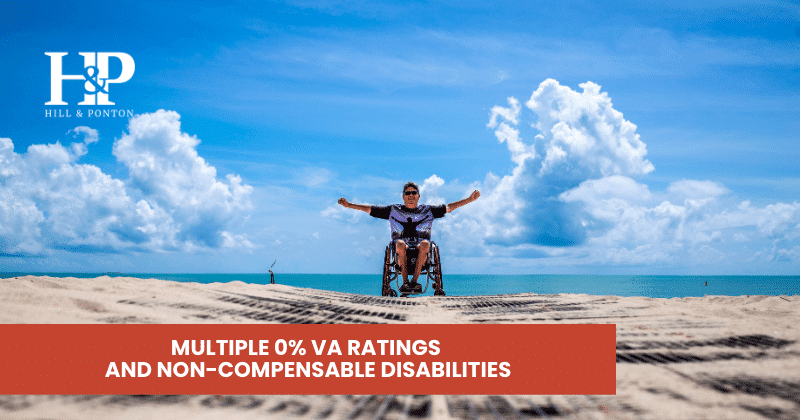When making a VA disability claim, veterans expect to receive a disability rating to determine their monthly compensation.
However, there are cases when the Department of Veterans Affairs determines service connection but rates a veteran’s disability at 0%.
This 0% VA disability rating means the veteran won’t receive this monthly payment.
This is called a non-compensable rating.
Former military service members facing one or multiple 0% VA ratings may feel frustrated.
However, there still may be a path to compensation.
How Do Non-Compensable Ratings Work?
In determining how much compensation a veteran is eligible to receive, the VA utilizes a rating schedule to assign specific ratings to each disability.
Once a disability is established as service-connected, that disability will be rated a specific number, connected to a set dollar amount the veteran will receive.
The numbers typically increase in increments of ten, but the requirements for each rating vary by diagnostic code.
The VA uses VA math when calculating combined disability ratings for disability claims.
The combined rating then determines a set dollar amount for compensation.
To determine your potential overall disability rating, you can input your disabilities and ratings into our disability calculator here.
However, many service-connected disabilities are defined as non-compensable and, therefore, will automatically receive a rating of 0% by the VA.
Further, if a veteran establishes a service-connected disability that does not include symptoms or injuries required for a higher rating, then the veteran may only receive a 0% non-compensable rating for the specific disability.
A 0% rating means the veteran will not be entitled to any compensation for their disability.
However, the veteran will still be eligible for several other VA benefits, such as VA health care, life insurance, and an allowance for travel costs related to medical appointments at a VA medical facility.
How Can Veterans Obtain Compensation Benefits?
One way for a veteran with multiple non-compensable service-connected disabilities to obtain compensation benefits is to establish that the disabilities directly affect the veteran’s ability to work.
38 CFR § 3.324 states:
“Whenever a veteran is suffering from two or more separate permanent service-connected disabilities of such character as clearly to interfere with normal employability, even though none of the disabilities may be of compensable degree…the rating agency is authorized to apply a 10-percent rating, but not in combination with any other rating.”
In other words, if you have multiple (two or more) non-compensable service-connected disabilities, the VA may assign you a 10% disability rating if the disabilities clearly interfere with your normal employability.
Many veterans in the United States have multiple non-compensable service-connected disabilities that affect employability and yet are not receiving any disability compensation that they are entitled to. Disabled veterans would be able to obtain some compensation through this method.
In addition, there are many disabilities that cannot receive a rating code higher than 0% and therefore are always non-compensable.
Finally, there are many disabilities that can be compensable, but, as explained above, a veteran does not manifest specific ailments or symptoms required for a higher rating than 0% and, therefore, receives a 0% non-compensable disability designation.
Evidence and Proving Service-connected Disabilities
If you are a veteran who falls within the above categories, with multiple non-compensable service-connected disabilities, it is important to document and seek treatment for all of your disabilities since the 10% rating to receive compensation under 38 CFR § 3.324 is not automatic.
However, the statute makes compensation available for veterans who establish that they are unable to work as a result of the disability.
The best way to prove this is to present evidence, including but not limited to medical records and employer statements regarding unemployability.
These pieces of medical evidence and lay statements will show how your disabling condition makes it impossible for you to hold a job and earn an income.
Limitations
It should be noted that a veteran can only receive a maximum of a 10% rating when combining multiple non-compensable service-connected disabilities.
If a veteran eventually receives a compensable disability rating at or equal to 10%, the veteran can only receive compensation based on that new rating, and the previous 10% rating (based on multiple non-compensable service-connected disabilities) will be removed.
Have Questions About Appealing Your Claim or Understanding How the Claims Process Works?
The attorneys at Hill & Ponton are here to support you with appealing a claim to get benefits.
If you are intending to appeal a denied claim, you can contact us for an evaluation and we can help you with this process.
However, if you are considering filing an initial claim, or even if you are interested in learning about the appeals process, we offer a free ebook to get you started on the right foot!
The Road to VA Compensation Benefits will help break down the claims process from start to finish. Click the link below to learn more.





